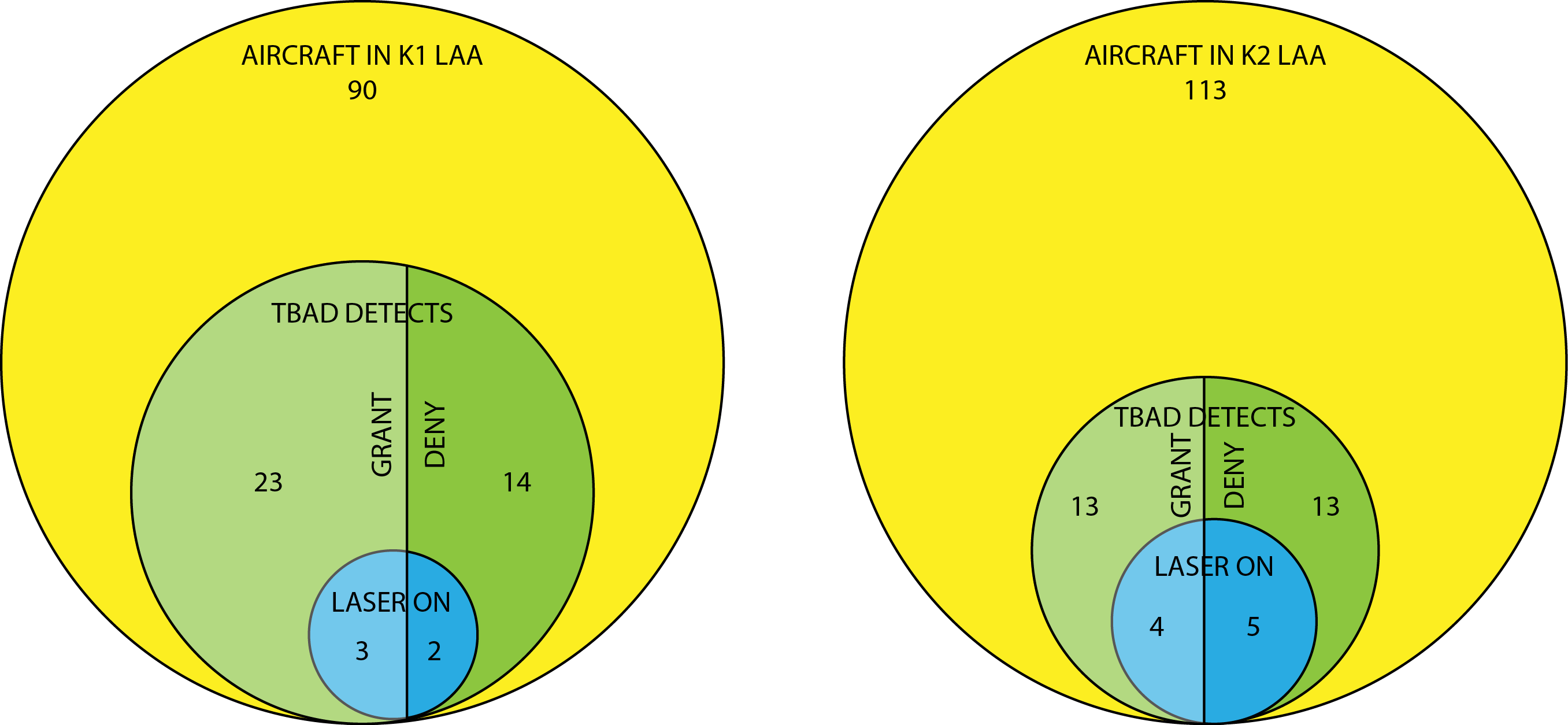
Keck Observatory TBAD Performance Overview
The W. M. Keck Observatory produced a report in June 2015 providing an analysis of the TBAD systems installed on the Keck I and Keck II 10-meter telescopes on Mauna Kea. This report, authored by Paul Stomski, Randy Campbell, Maura Mastriani, and Eric Appleby may be available by request to the Keck Observatory.
The Keck Observatory has approved the presentation of information on this page, but notes that the results presented are based on historical performance, and are not a prediction of future performance or the results that may be obtained at any other facility.
These diagrams, inspired by their clever introduction in the Keck
Observatory report, nicely display the frequency of certain types of events
for the two Keck Observatory telescopes.

The left-hand diagram is for the Keck I telescope and the right-hand diagram is for the Keck II telescope. What we see is that of the 90 airplanes in the laser-affected area (above 20° altitude, essentially) during the Keck I TBAD operational period, 37 (23 plus 14) were detected by TBAD. This should not be alarming: TBAD peers out of a telescope dome slit with a partial view of the sky at any given time. Of those 37 detections, the AIRSAFE system (the Keck Observatory integrated laser propagation safety framework) GRANTed permission to operate 23 times. The laser system was actually in use for only five of the airplanes, two of which caused the laser to shut off (DENY condition).
On the right, we see that 26 of the 113 events were noted by TBAD, half of which would have caused closure (DENY) had the laser been propagating. As it was, only 9 airplanes were detected in the LAA when the Keck II telescope's laser was propagating, five of which caused the laser to shutter off.
All indications are that TBAD continues to perform properly in every instance.
Nuisance detections (a.k.a. "false positives") are negligible. There have not been any instances of false shutter events.
In the context of 18 overflights studied in detail during commissioning of the Keck I telescope's TBAD:
We looked look for planes that TBAD should have seen but did not: the conclusion was that there were no instances of this failure mode.
We got 3 good test cases for high flying commercial aircraft that would have caused TBAD to shutter the laser. (UAL840 on Feb 16, UAL840 on May 6, and VOZ8 on Feb 22) These instance were all analyzed and confirmed to have been handled properly by TBAD and AIRSAFE [the Keck Observatory integrated safety system].
In the context of charter flight passes, 27 viewed by the Keck II telescope's TBAD and 23 by Keck I:
[both] responded properly to each and every test pattern coinciding with reasonably expected air traffic. Both the original and the newer TBAD also performed well on charter aircraft test patterns that were well outside of what is reasonable to expect such as extremely low/close fly-bys.
Concluding statements:
The Keck Observatory aircraft protection systems correctly detected and responded to all aircraft in our laser affected airspace during this period. The systems also performed well in all types of testing that we performed. Performance of the systems continues to comply with AS-6029A.
Note that TBADs capabilities have been shown in testing to be AS-6029A compliant for aircraft well beyond just what is reasonably expected.